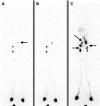Lymphatic system anomalies in Crouzon syndrome
- PMID: 21686735
- PMCID: PMC3030293
- DOI: 10.1136/bcr.07.2008.0586
Lymphatic system anomalies in Crouzon syndrome
Abstract
Crouzon syndrome is a rare genetic disorder characterised mainly by distinctive malformations of the skull and facial region and caused by mutations in the fibroblast growth factor receptor 2 (FGFR2) gene. No study reported on oedemas related to lymphatic system abnormalities in these patients. A case of Crouzon syndrome displaying classic facial anomalies but also with bilateral lower limb oedema is reported in whom lymphoscintigraphic investigation of the limbs clearly delineated the presence of lymphatic system anomalies.
Figures
Similar articles
-
Extremely severe scoliosis, heterotopic ossification, and osteoarthritis in a three-generation family with Crouzon syndrome carrying a mutant c.799T>C FGFR2.Mol Genet Genomic Med. 2019 Sep;7(9):e843. doi: 10.1002/mgg3.843. Epub 2019 Jul 18. Mol Genet Genomic Med. 2019. PMID: 31318164 Free PMC article.
-
An inherited FGFR2 mutation increased osteogenesis gene expression and result in Crouzon syndrome.BMC Med Genet. 2018 May 30;19(1):91. doi: 10.1186/s12881-018-0607-8. BMC Med Genet. 2018. PMID: 29848297 Free PMC article.
-
FGFR2 exon IIIa and IIIc mutations in Crouzon, Jackson-Weiss, and Pfeiffer syndromes: evidence for missense changes, insertions, and a deletion due to alternative RNA splicing.Am J Hum Genet. 1996 Mar;58(3):491-8. Am J Hum Genet. 1996. PMID: 8644708 Free PMC article.
-
Molecular diagnosis of bilateral coronal synostosis.Plast Reconstr Surg. 1999 Nov;104(6):1603-15. doi: 10.1097/00006534-199911000-00001. Plast Reconstr Surg. 1999. PMID: 10541159 Review.
-
Crouzon syndrome with bony upper airway obstruction: case report and review literature.Fetal Pediatr Pathol. 2014 Aug;33(4):199-201. doi: 10.3109/15513815.2014.913747. Epub 2014 May 14. Fetal Pediatr Pathol. 2014. PMID: 24828762 Review.
Cited by
-
Extremely severe scoliosis, heterotopic ossification, and osteoarthritis in a three-generation family with Crouzon syndrome carrying a mutant c.799T>C FGFR2.Mol Genet Genomic Med. 2019 Sep;7(9):e843. doi: 10.1002/mgg3.843. Epub 2019 Jul 18. Mol Genet Genomic Med. 2019. PMID: 31318164 Free PMC article.
References
-
- Fries PD, Katowitz JA. Congenital craniofacial anomalies of ophthalmic importance. Surv Ophthalmol 1990; 35: 87–119 - PubMed
-
- Oldridge M, Wilkie AO, Slaney SF, et al. Mutations in the third immunoglobulin domain of the fibroblast growth factor receptor-2 gene in Crouzon syndrome. Hum Mol Genet 1995; 4: 1077–82 - PubMed
-
- Bourgeois P, Munck D, Sales F. Anomalies of thoracic lymph duct drainage demonstrated by lymphoscintigraphy and review of the literature about these anomalies. Eur J Surg Oncol 2008; 34: 553–5 - PubMed
LinkOut - more resources
Full Text Sources
Miscellaneous

